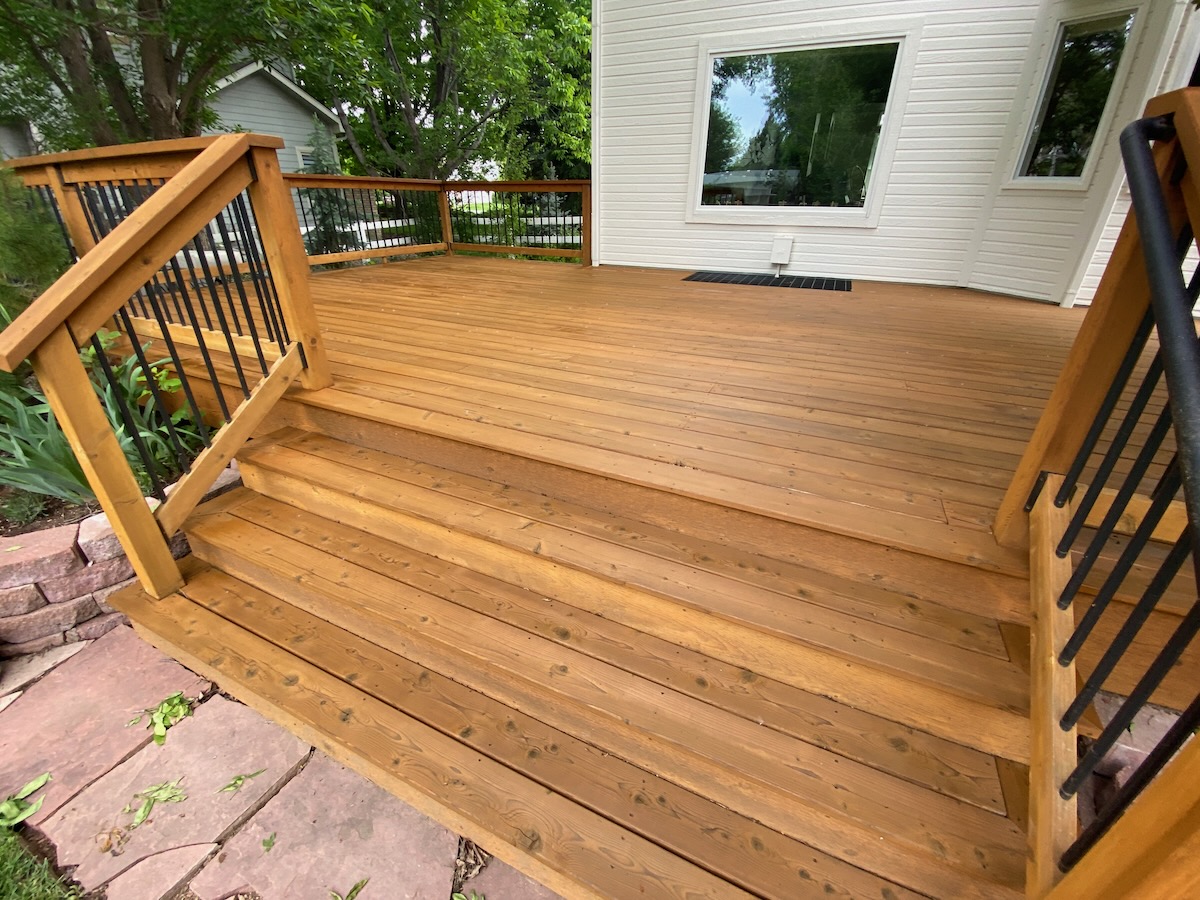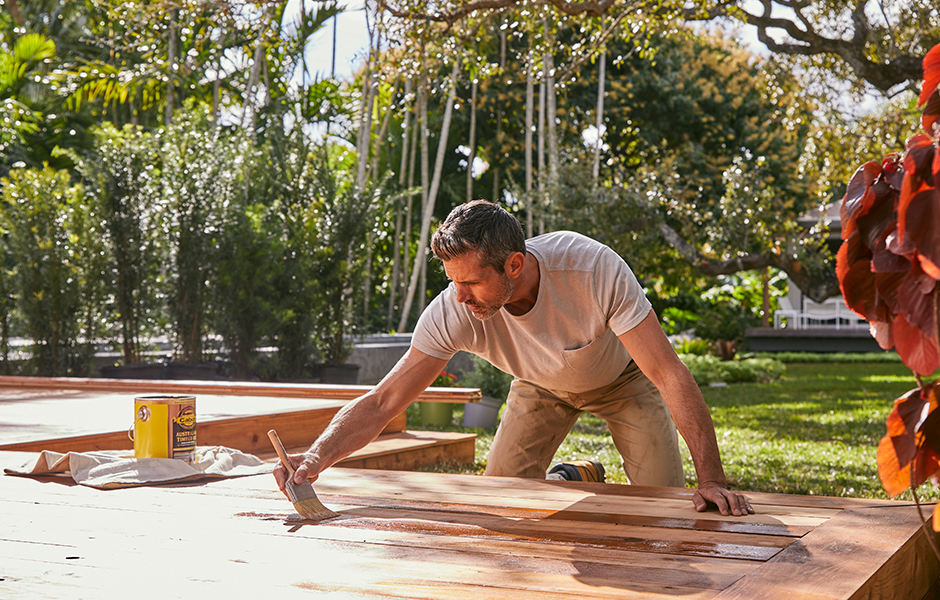Water-Based Stains for a Beautiful Deck: Eco-Friendly and Effective
Water-Based Stains for a Beautiful Deck: Eco-Friendly and Effective
Blog Article
A Comprehensive Overview to Different Types of Deck Staining Techniques for Ultimate Protection and Looks
In the world of deck maintenance, the art of tarnishing stands as a crucial action in the direction of both maintaining the honesty of your outside room and enhancing its aesthetic appeal. As we browse via the complex world of deck staining techniques, one starts to value the nuanced strategies that can make all the distinction in between a sub-par coating and a remarkable one. From the choice of the proper discolor type to the meticulous application methods, each aspect plays an essential role in achieving that excellent equilibrium between security and appearances. Join us as we reveal the tricks behind achieving the ultimate deck discoloration results-- a journey where every brushstroke shapes not just the surface, yet the extremely essence of your exterior shelter.
Understanding Various Types of Discolorations
Various sorts of stains are typically used in the process of deck discoloration to accomplish various aesthetic and safety results. Transparent discolorations are ideal for showcasing the natural grain of the timber while providing very little security versus UV rays and moisture. On the various other hand, semi-transparent stains provide an equilibrium in between color improvement and protection, enabling some timber grain to show through. For an extra opaque surface that gives maximum security versus the components, solid spots are the recommended choice. These spots can be found in a vast array of shades and efficiently hide the timber grain.
In addition, there are also specialized stains such as toners and sealers. Toners include a tip of shade to the timber while providing minimal security, making them ideal for more recent decks with much less wear. Sealants, on the various other hand, deal defense versus dampness and UV rays without including shade, making them a preferred selection for decks that currently flaunt a preferable tone. Understanding the qualities and benefits of each sort of stain is essential for achieving the preferred look and toughness for your deck.
Selecting the Right Stain Shade
When thinking about the aesthetics of your deck discoloration project, the selection of discolor color plays an important role in boosting the safety top qualities of the picked discolor kind (Right Deck Stain). The shade you select can considerably influence the total appearance of your deck, as well as its capacity to stand up to the elements with time
When choosing a discolor color, it's important to think about the existing color pattern of your home's exterior. Integrating the deck discolor with the overall visual of your residential property can create a natural and visually attractive exterior space. Furthermore, the shade of your deck discolor can affect the temperature of the deck surface area; darker colors often tend to absorb more warmth, while lighter shades show sunshine and stay cooler.
Additionally, the sort of wood you are discoloring will certainly also influence exactly how the tarnish color appears. Various timber species can engage with the discolor in different ways, possibly modifying the final color. It's a good idea to check the tarnish on a little, low-profile location of the deck to ensure the color transforms out as preferred before continuing with the whole project.
Preparing Your Deck for Staining
To make certain a lasting and successful deck staining task, comprehensive preparation of the deck surface is important. Begin by cleaning the deck thoroughly to get rid of dust, grime, mold, and any kind of old complete or stain.
Inspect the deck for any damaged or rotten boards that require to be changed. Hammer down any type of protruding nails and sand any harsh locations to make sure a smooth surface area for staining. Examine for any kind of loose railings or actions that may need tightening or fixing.
As soon as the deck important link is clean, dry, and in excellent repair service, think about applying a timber brightener to restore the deck's all-natural color and open up the timber pores for much better tarnish penetration. Ultimately, safeguard any kind of close-by plants, furniture, or surface areas with plastic sheeting prior to waging the staining procedure. Proper prep work is essential to accomplishing a professional-looking finish and optimizing the longevity of your deck discolor.
Applying Discoloration With Different Strategies
For a specialist and flawless surface, the technique of using stain plays a crucial function in improving the look and resilience of your deck. There are a number of strategies you can make use of to ensure a reliable application of stain.
Cleaning is webpage a standard technique that enables precision and control over the amount of stain applied. It is excellent for intricate areas and reaching in between deck boards (Water-Based Stains). Rolling is a quicker option, covering larger area effectively. Nevertheless, back-brushing after rolling is suggested to level the discolor and function it right into the timber for much better infiltration.
Spraying is another preferred method, providing speed and convenience of application, particularly for large deck locations. Whichever technique you pick, making sure proper prep work and complying with supplier guidelines will certainly assist achieve a durable and beautiful discolor finish on your deck.

Keeping and Re-staining Your Deck
Correct upkeep and timely re-staining are vital for preserving the beauty and long life of your deck. Normal upkeep tasks include brushing up off debris, cleaning with a deck cleaner, and inspecting for any kind of indications of wear or damages. Dealing with concerns quickly can stop much more significant troubles in the future. When it pertains to re-staining your deck, the frequency depends on numerous aspects such as the kind of stain made use of, the climate in your location, and how much wear and tear your deck experiences. Usually, it is suggested to re-stain your deck every 2-4 years to maintain its defense and looks.
Prior to re-staining, make certain the deck is tidy, dry, and complimentary of any kind of previous tarnish deposit. Pick a top quality discolor that fits your deck's material and provides the desired level of protection.
Conclusion
To conclude, understanding the different sorts of deck stains, choosing the best color, correctly preparing the deck, applying stain with various techniques, and re-staining the deck and maintaining are crucial actions for utmost security and looks. By adhering to these actions, you can guarantee that your deck remains in top condition for many years ahead.
In addition, the color of your deck stain can affect the temperature level of the deck surface; darker shades have a tendency to soak up more warm, while lighter colors reflect sunshine and stay cooler.
It's suggested to examine the tarnish on a little, inconspicuous location of the deck to make sure official website the color transforms out as desired before continuing with the whole project.

Report this page